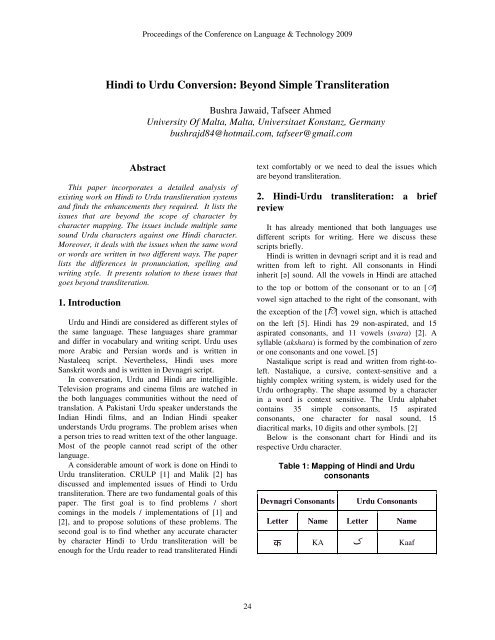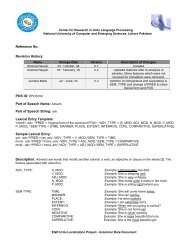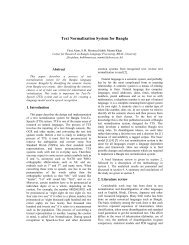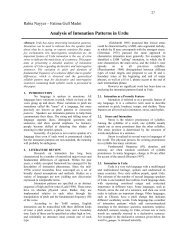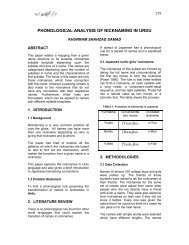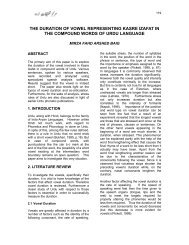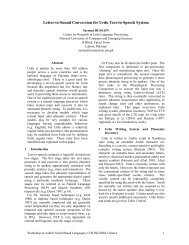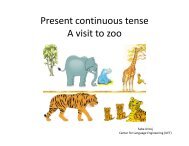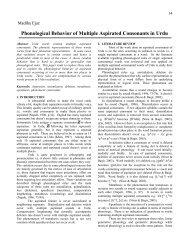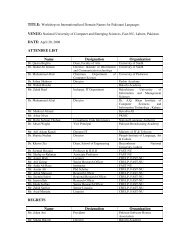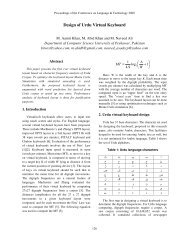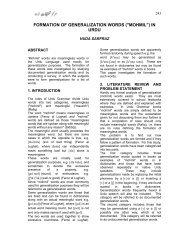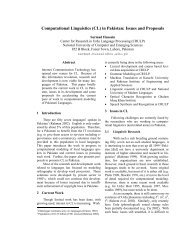Hindi to Urdu Conversion: Beyond Simple Transliteration
Hindi to Urdu Conversion: Beyond Simple Transliteration
Hindi to Urdu Conversion: Beyond Simple Transliteration
Create successful ePaper yourself
Turn your PDF publications into a flip-book with our unique Google optimized e-Paper software.
Proceedings of the Conference on Language & Technology 2009<br />
<strong>Hindi</strong> <strong>to</strong> <strong>Urdu</strong> <strong>Conversion</strong>: <strong>Beyond</strong> <strong>Simple</strong> <strong>Transliteration</strong><br />
Bushra Jawaid, Tafseer Ahmed<br />
University Of Malta, Malta, Universitaet Konstanz, Germany<br />
bushrajd84@hotmail.com, tafseer@gmail.com<br />
Abstract<br />
This paper incorporates a detailed analysis of<br />
existing work on <strong>Hindi</strong> <strong>to</strong> <strong>Urdu</strong> transliteration systems<br />
and finds the enhancements they required. It lists the<br />
issues that are beyond the scope of character by<br />
character mapping. The issues include multiple same<br />
sound <strong>Urdu</strong> characters against one <strong>Hindi</strong> character.<br />
Moreover, it deals with the issues when the same word<br />
or words are written in two different ways. The paper<br />
lists the differences in pronunciation, spelling and<br />
writing style. It presents solution <strong>to</strong> these issues that<br />
goes beyond transliteration.<br />
1. Introduction<br />
<strong>Urdu</strong> and <strong>Hindi</strong> are considered as different styles of<br />
the same language. These languages share grammar<br />
and differ in vocabulary and writing script. <strong>Urdu</strong> uses<br />
more Arabic and Persian words and is written in<br />
Nastaleeq script. Nevertheless, <strong>Hindi</strong> uses more<br />
Sanskrit words and is written in Devnagri script.<br />
In conversation, <strong>Urdu</strong> and <strong>Hindi</strong> are intelligible.<br />
Television programs and cinema films are watched in<br />
the both languages communities without the need of<br />
translation. A Pakistani <strong>Urdu</strong> speaker understands the<br />
Indian <strong>Hindi</strong> films, and an Indian <strong>Hindi</strong> speaker<br />
understands <strong>Urdu</strong> programs. The problem arises when<br />
a person tries <strong>to</strong> read written text of the other language.<br />
Most of the people cannot read script of the other<br />
language.<br />
A considerable amount of work is done on <strong>Hindi</strong> <strong>to</strong><br />
<strong>Urdu</strong> transliteration. CRULP [1] and Malik [2] has<br />
discussed and implemented issues of <strong>Hindi</strong> <strong>to</strong> <strong>Urdu</strong><br />
transliteration. There are two fundamental goals of this<br />
paper. The first goal is <strong>to</strong> find problems / short<br />
comings in the models / implementations of [1] and<br />
[2], and <strong>to</strong> propose solutions of these problems. The<br />
second goal is <strong>to</strong> find whether any accurate character<br />
by character <strong>Hindi</strong> <strong>to</strong> <strong>Urdu</strong> transliteration will be<br />
enough for the <strong>Urdu</strong> reader <strong>to</strong> read transliterated <strong>Hindi</strong><br />
text comfortably or we need <strong>to</strong> deal the issues which<br />
are beyond transliteration.<br />
2. <strong>Hindi</strong>-<strong>Urdu</strong> transliteration: a brief<br />
review<br />
It has already mentioned that both languages use<br />
different scripts for writing. Here we discuss these<br />
scripts briefly.<br />
<strong>Hindi</strong> is written in devnagri script and it is read and<br />
written from left <strong>to</strong> right. All consonants in <strong>Hindi</strong><br />
inherit [ə] sound. All the vowels in <strong>Hindi</strong> are attached<br />
<strong>to</strong> the <strong>to</strong>p or bot<strong>to</strong>m of the consonant or <strong>to</strong> an [◌ा]<br />
vowel sign attached <strong>to</strong> the right of the consonant, with<br />
the exception of the [◌] vowel sign, which is attached<br />
on the left [5]. <strong>Hindi</strong> has 29 non-aspirated, and 15<br />
aspirated consonants, and 11 vowels (svara) [2]. A<br />
syllable (akshara) is formed by the combination of zero<br />
or one consonants and one vowel. [5]<br />
Nastalique script is read and written from right-<strong>to</strong>left.<br />
Nastalique, a cursive, context-sensitive and a<br />
highly complex writing system, is widely used for the<br />
<strong>Urdu</strong> orthography. The shape assumed by a character<br />
in a word is context sensitive. The <strong>Urdu</strong> alphabet<br />
contains 35 simple consonants, 15 aspirated<br />
consonants, one character for nasal sound, 15<br />
diacritical marks, 10 digits and other symbols. [2]<br />
Below is the consonant chart for <strong>Hindi</strong> and its<br />
respective <strong>Urdu</strong> character.<br />
Table 1: Mapping of <strong>Hindi</strong> and <strong>Urdu</strong><br />
consonants<br />
Devnagri Consonants<br />
<strong>Urdu</strong> Consonants<br />
Letter Name Letter Name<br />
क KA Kaaf<br />
24
Proceedings of the Conference on Language & Technology 2009<br />
ख KHA Kaaf-Hay<br />
ग GA Gaaf<br />
घ GHA Gaaf-Hay<br />
ङ NGA Noon<br />
च CA Chay<br />
छ CHA Chay-Hay<br />
ज JA Jeem<br />
झ JHA Jeem-Hay<br />
ञ NYA <br />
ट TTA Ttay<br />
ठ TTHA Ttay-Hay<br />
ड DDA Ddaal<br />
ढ DDHA Ddaal-Hay<br />
ण NNA <br />
त TA Tay/ Toay<br />
थ THA Tay-Hay<br />
द DA Daal<br />
ध DHA Daal-Hay<br />
न NA Noon<br />
प PA Pay<br />
फ PHA Pay-Hay<br />
ब BA Bay<br />
भ BHA Bay-Hay<br />
म MA Meem<br />
य YA Bari-Yeh<br />
र RA Ray<br />
ल LA Laam<br />
व VA Wow<br />
श SHA Sheen<br />
ष SSA Sheen<br />
स<br />
SA<br />
<br />
<br />
Seen/ Saay/<br />
Suad<br />
ह HA aa<br />
Hay<br />
Below is the Vowel chart for <strong>Hindi</strong> and <strong>Urdu</strong>.<br />
Table 2: Mapping of <strong>Hindi</strong> and <strong>Urdu</strong> vowels<br />
<strong>Hindi</strong> Vowels<br />
Letter<br />
Diacritical<br />
Mark<br />
<strong>Urdu</strong> Vowels<br />
Letter<br />
Vowel<br />
अ ə<br />
आ ◌ा ǡ<br />
इ ◌ ِ ɪ<br />
ई ◌ी i<br />
उ ◌ु ُ ʊ<br />
ऊ ◌ू ۇ u<br />
25
Proceedings of the Conference on Language & Technology 2009<br />
ऋ<br />
◌ृ<br />
ر + ِ<br />
(consonant +<br />
vowel)<br />
ए ◌े e<br />
ऐ ◌ै <br />
<br />
æ<br />
ओ ◌ो ٱ o<br />
औ ◌ौ ٱ ɔ<br />
In Table 2 we have listed all the <strong>Urdu</strong> vowel<br />
symbols or group of vowels against each <strong>Hindi</strong> vowel<br />
<strong>to</strong> represent <strong>Hindi</strong> vowel sounds. Only exception is<br />
vowel “ऋ” whose vowel sound maps on <strong>Urdu</strong><br />
consonant and vowel character sounds. Current<br />
transliteration systems don’t provide support for the<br />
independent form of this vowel. CRULP’s output for<br />
.”شॠِ“ the sample word ॠष (rishi) is<br />
Here we are writing down few sample words by<br />
reading those a reader can have an idea of difference in<br />
writing style of both languages.<br />
दुकानदार<br />
नमते<br />
टमाटर<br />
<br />
<br />
<br />
3. Issues in <strong>Hindi</strong>-<strong>Urdu</strong> conversion<br />
The paper discusses the issues in <strong>Hindi</strong> <strong>to</strong> <strong>Urdu</strong><br />
conversion that are remained unsolved in CRULP’s<br />
and Malik’s system. To identify these problems we<br />
made a small survey of <strong>Hindi</strong> text available at [3] and<br />
[4]. We transliterated the <strong>Hindi</strong> text <strong>to</strong> <strong>Urdu</strong> using<br />
CRULP’s <strong>Hindi</strong> <strong>to</strong> <strong>Urdu</strong> translitera<strong>to</strong>r. The problems<br />
identified in the converted text are listed. We explored<br />
Malik’s solution <strong>to</strong> find whether his algorithm and<br />
structures have solution of these problems. It was<br />
found that most of the problems are not solved by his<br />
model <strong>to</strong>o.<br />
The identified issues are of three types. The first type<br />
of issues has unsolved problems in character by<br />
character transliteration of <strong>Hindi</strong> text in<strong>to</strong> <strong>Urdu</strong> script.<br />
But there are issues that are beyond the scope of<br />
character <strong>to</strong> character transliteration. There are<br />
ṛ<br />
differences in writing style and vocabulary. We are<br />
presenting list of all these issues in the following text.<br />
Most of the <strong>Hindi</strong> presented in the following discussion<br />
is taken from [3] and [4] and few example sentences<br />
are constructed. In section 4, we will present solutions<br />
for these issues.<br />
3.1. <strong>Transliteration</strong> between different scripts<br />
After transliterating the <strong>Hindi</strong> text by exploiting the<br />
CRULP’s translitera<strong>to</strong>r and later on comparing those<br />
results with the expected output of Malik’s system, we<br />
found following issues that remained unsolved in either<br />
one or both of the systems.<br />
3.1.1. Same/similar sound character. In the following<br />
example sentence, the word “” is not transliterated<br />
correctly. In problem-word “t” sound character should<br />
be transliterated in<strong>to</strong> “” instead of “”.<br />
(1) यह दोन क ग़लती है<br />
a<br />
aaa<br />
Similar sound character problem always occurs due<br />
<strong>to</strong> multiple <strong>Urdu</strong> characters against one <strong>Hindi</strong><br />
character, as can be seen in table 1. For the same<br />
reason, the wrong selection of character has often<br />
.”ہ“ found for words that end on<br />
(2) तुम खाना हमेशा बहुत अछा बनाती<br />
हो<br />
aa a a<br />
aa <br />
<br />
In (2), for example, word “” is written with “”<br />
instead of “”. Table 4 gives the list of same sound<br />
<strong>Urdu</strong> characters.<br />
Table 4: List of same sound <strong>Urdu</strong> characters<br />
Sounds<br />
<strong>Urdu</strong><br />
Characters list<br />
for each sound<br />
Character<br />
Default<br />
Characters for<br />
<strong>Transliteration</strong><br />
t sound <br />
s sound a a <br />
z sound a a a <br />
26
Proceedings of the Conference on Language & Technology 2009<br />
a sound <br />
a sound -at-end <br />
Systems that are built for <strong>Hindi</strong> <strong>to</strong> <strong>Urdu</strong> transliteration<br />
currently have fixed transliteration rules defined for<br />
same sound character mapping. Those rules map<br />
<strong>Hindi</strong>’s same sound characters on default <strong>Urdu</strong><br />
characters as defined in Table 4.<br />
3.1.2. Characters similar in Shape. <strong>Transliteration</strong><br />
errors that occasionally occur are primarily due <strong>to</strong> the<br />
charcters that are exactly identical in shape in Devnagri<br />
script and differs only by a dot addition. Errors are<br />
rarely found because of the missing dots and mostly<br />
due <strong>to</strong> the pronunciation differences between the<br />
speakers of the both languages.<br />
(3) भारती गज़लीं बहुत पसद क जाती ह<br />
aaaaaa<br />
a<br />
Table 5: Chart of similar shape <strong>Hindi</strong><br />
characters<br />
<strong>Urdu</strong> <strong>Hindi</strong> <strong>Transliteration</strong> Errors<br />
<br />
<br />
<br />
<br />
ज़, ज<br />
<br />
ख़, ख a a <br />
<br />
फ़, फ <br />
<br />
ग़, ग <br />
3.1.3. Nasalized sound character. In <strong>Urdu</strong> consonants<br />
chart we have a single character <strong>to</strong> represent nasalized<br />
sound known as “noon-ghunna” ().<br />
<strong>Hindi</strong> script has “chandrabindu” (◌ँ) and “bindu”<br />
(◌ं) diacritics <strong>to</strong> represent nasalized sound. There are<br />
two problems in mapping of chandrabindu/bindu <strong>to</strong><br />
<strong>Urdu</strong> script. The first problem arises when this<br />
nasalized sound character occurs in the middle of the<br />
word, as shown in (4):<br />
(4) यह इंडया गेट है<br />
aa<br />
<br />
<br />
a<br />
In <strong>Urdu</strong> when noon-ghunna comes in the middle of<br />
the word it is replaced by noon. Current transliteration<br />
systems map <strong>Hindi</strong> nasalized characters with noonghunna<br />
of <strong>Urdu</strong> irrespective of its position in the word.<br />
The second issue is that few words in <strong>Urdu</strong> contain<br />
character “” but in pronunciation they produce<br />
nasalized sound.<br />
(5) जीट रोड क लंबाई कतनी है?<br />
<br />
a aaaa<br />
<strong>Hindi</strong> speakers write these words the way they<br />
pronounce it. That’s why in the result of transliteration<br />
we get “noon-ghunna” instead of “”, as in (5).<br />
3.1.4. Kasr-e-Izafat Issue. Kasr-e-Izafat is represented<br />
by (Zer) at the end of a word and is used <strong>to</strong> connect<br />
two words <strong>to</strong> form the compound word e.g. a <br />
Words having izafat symbol produces [e] sound<br />
effect during pronunciation. In devnagri script there is<br />
no concept of izafat <strong>to</strong> produce [e] sound that’s why<br />
Indian native speakers use diacritical mark [◌े] whose<br />
independent form is [ए] in place of the diacritical mark<br />
[◌] whose independent form is [इ] for writting these<br />
words.<br />
(6) मीनारे पाकतान लाहौर म है<br />
a a<br />
<br />
Thus, this wrong diacritical marking as in (6) produces<br />
instead of Izafat sign (Zer). Solution of the above (ے)<br />
is not present in either of the two systems.<br />
3.2. Different writing style<br />
Even if a character by character mapping is modeled<br />
successfully, there remain few differences in writing<br />
conventions of <strong>Urdu</strong> and <strong>Hindi</strong>. These problems are<br />
beyond the scope of transliteration, and hence are not<br />
discussed in the two earlier works [1] and [2], but these<br />
should be addressed because the <strong>Urdu</strong> reader expects <strong>to</strong><br />
read the text having <strong>Urdu</strong> conventions.<br />
3.2.1. Native words. There is a difference in writing<br />
conventions of native Indic words in <strong>Hindi</strong> and <strong>Urdu</strong>.<br />
Problem has been found in those words which end up<br />
on vowel sound. <strong>Hindi</strong> language can have words that<br />
27
Proceedings of the Conference on Language & Technology 2009<br />
end on short vowel but <strong>Urdu</strong> language doesn’t contain<br />
words that end on short vowel.<br />
The first issue arises for the words which end up on<br />
short vowel character. In <strong>Urdu</strong> writing system when a<br />
short vowel comes at the end of the word it is written<br />
as a long vowel, as illustrated in example (7):<br />
(7) नई दली म पािलयामैट और<br />
रा पित<br />
भवन है<br />
aaa<br />
<br />
aaaa a<br />
Observe that the word “ ” has short vowel<br />
ending. CRULP’s translitera<strong>to</strong>r has not dealt with this<br />
issue whereas Malik [2] has presented his idea on a<br />
particular problem but this problem is also present in<br />
his system.<br />
<strong>Hindi</strong> and <strong>Urdu</strong> share a basic common vocabulary<br />
that includes pronouns and auxiliaries. Errors in<br />
transliteration occur because of different writing<br />
conventions which have been followed for words that<br />
are being used by both language speakers from same<br />
set of vocabulary. As shown in (8): a pronoun “” is<br />
transliterated as “”.<br />
(8) ये मरिगला क पहाड़याँ ह<br />
a aa a<br />
<br />
This issue is often found in words “”, “ ”, “ ”<br />
and “ ”. First three in pronunciations produce [e]<br />
sound that’s why they are written with “”. However,<br />
the pronoun “ ” is exception. It has been found in two<br />
different writing styles in <strong>to</strong>day’s <strong>Hindi</strong> text i.e. “”<br />
and “” which is transliterated form of “वो” and<br />
“वे”.<br />
3.2.2. Short vowel for Vao. Words adopted by <strong>Hindi</strong><br />
speakers from <strong>Urdu</strong> (Persio-Arabic) vocabulary have<br />
issues like wrong marking of ”و“ with short vowel pesh<br />
(ُ◌). This problem does not occur for all instances of<br />
vao in <strong>Urdu</strong>.<br />
(9) या हुआ?<br />
a<br />
<br />
<br />
a<br />
Same problem has been found in words borrowed<br />
from English vocabulary.<br />
(10) म अभी पुिलस बुलाती हूँ<br />
a a<br />
aa<br />
<br />
<br />
<br />
<br />
In example (10) “ ” is the transliteration of<br />
English word “police”. This transliteration is correct<br />
according <strong>to</strong> its pronunciation but <strong>Urdu</strong> speakers write<br />
“police” using long vowel: as “ ”.<br />
3.2.3. Persio-Arabic words. <strong>Urdu</strong>’s vocabulary is<br />
comprised of many Persio-Arabic words. These<br />
borrowings have their own writing conventions which<br />
<strong>Urdu</strong> speakers generally follow.<br />
When <strong>Hindi</strong> speakers write persio-arabic words they<br />
don’t follow the writting scheme of these borrowings.<br />
Issues have been seen in the words that have silent-<br />
Alif. <strong>Hindi</strong> speakers neglect silent-alif part in writing<br />
because of the unawareness with the correct form of the<br />
word. The lack in familiarity with the correct form of<br />
the words is depicted as in (11):<br />
(11) म फ़लहाल अपने घर जा रहा हूँ<br />
aaaa <br />
a<br />
<br />
<br />
<br />
a<br />
Problem-word in example (11) is “” and its<br />
correct form is “a”.<br />
Another problem occurs with the persio-arabic<br />
words with “” sound. When “” is followed by [u]<br />
sound, they are mostly written with short vowel (ُ)<br />
(equivalent of Pesh) in <strong>Hindi</strong> text. This issue is<br />
discussed in detail in 3.2.2<br />
(12) मुझे ख़ुशी है क तुम मेरे पास हो<br />
aaaaa aa<br />
a <br />
<br />
3.3. Multi-morphemes without space<br />
If we analyze <strong>Hindi</strong> text we would find out frequent<br />
use of multi-morphemes words. These words are<br />
typically associated with the different problem-groups.<br />
Below we have discussed these groups and have<br />
morphologically correlated <strong>Hindi</strong> and <strong>Urdu</strong> grammars.<br />
28
Proceedings of the Conference on Language & Technology 2009<br />
3.3.1. Case markers after pronouns (+ 'sab'). In<br />
<strong>Hindi</strong> and <strong>Urdu</strong> sentence structures we use case<br />
markers. These markers can be identified<br />
grammatically as non-semantic prepositions. In <strong>Hindi</strong><br />
text, these case markers when use with the pronouns<br />
disowns their individual form and coalesce with the<br />
pronoun.<br />
(13) तुमने फ़म कभी नहं देखी?<br />
aaaa<br />
<br />
<br />
In (13) case marker “” is joined with a pronoun<br />
“ ”. Nevertheless, the word “” is not a pronoun<br />
but it also follows the same principle. <strong>Hindi</strong> writers<br />
also write it in conjunction with the case markers. This<br />
is illustrated by the example in (14):<br />
(14) सबसे यादा गम राजथान म पड़ती है<br />
aaaaa a<br />
<br />
In the above example, “” has subjected <strong>to</strong> the<br />
unnecessary joining.<br />
3.3.2. gaa / gii / ge after verb. <strong>Hindi</strong> and <strong>Urdu</strong><br />
grammar share the same auxiliaries <strong>to</strong> define aspect<br />
and tense. In <strong>Urdu</strong> language, auxiliaries and basicverbs<br />
are written standalone; however, in <strong>Hindi</strong> text the<br />
verbs are concatenated with the future auxiliaries<br />
“gaa”, “gii” and “ge”.<br />
(15) या अब मेर पी मुझे पहचान सके गी?<br />
<br />
<br />
aaaaa a<br />
<br />
The verb “” in (15) is followed by the future<br />
marker “”. These two are written as a single word<br />
i.e. “” and <strong>Urdu</strong> speakers are mostly not familiar<br />
with this form of the verb.<br />
3.3.3. kar/ke after verb. Both <strong>Hindi</strong> and <strong>Urdu</strong><br />
languages include conjunctions. These conjunctions<br />
are basically used <strong>to</strong> join two words or phrases<br />
<strong>to</strong>gether. <strong>Urdu</strong> language considers these conjunctions<br />
as individual word forms thus they are written<br />
separately. While in <strong>Hindi</strong> content conjunctions “kar”<br />
and “ke” are joined with the preceding verb.<br />
(16) फर याद चलकर मेरे पास य आती है<br />
aaaaa<br />
<br />
aa<br />
<br />
In example (16) “” is problem-word in which<br />
“” has been connected with “” and this association<br />
has created new form of word which is neither a part of<br />
<strong>Urdu</strong> word list nor familiar for <strong>Urdu</strong> readers.<br />
3.3.4. Compound words. <strong>Urdu</strong> language has<br />
compound words in its vocabulary. These words are<br />
based on multiple constituent words. These constituent<br />
words when written in compound form give new<br />
essence <strong>to</strong> the word. In <strong>Urdu</strong>, the general rule of<br />
writing compound word is <strong>to</strong> put space among the<br />
constituents however <strong>Hindi</strong> writers usually don’t follow<br />
this convention; they write it by connecting the<br />
constituents <strong>to</strong>gether.<br />
(17) रानी टैिलफ़ोन पर चाची से बातचीत कर<br />
रह है<br />
aaa<br />
<br />
aaaaa<br />
<br />
<strong>Urdu</strong> glossary contains compound word “a ”<br />
which is consisted of two consitutents. As we can see in<br />
(17) these constituents are merged <strong>to</strong>gether hence<br />
generated new construction for the same compound<br />
word: “”.<br />
3.4. Difference in vocabulary<br />
Although both languages share a lot of words that<br />
includes native (Indian), Arabic, Persian, and English<br />
loanwords but still <strong>Hindi</strong> and <strong>Urdu</strong> words differ at<br />
some places because one is using the words having<br />
Arabic or Persian origion while other is using the<br />
Sanskrit loanwords. Differences have been noticed in a<br />
close class words and also in a general vocabulary.<br />
Table 6: Examples of difference in vocabulary<br />
in <strong>Urdu</strong> and <strong>Hindi</strong><br />
Close Class Words Open Class Words<br />
<strong>Hindi</strong> <strong>Urdu</strong> <strong>Hindi</strong> <strong>Urdu</strong><br />
دوارا<br />
سے ايتِہاسِک تاريخی کارن<br />
وجہ سے راجنيت ی سياست There is a difference in the use of pronoun “ <br />
”. In<br />
<strong>Urdu</strong>, it is used for both singular and plural. But in<br />
<strong>Hindi</strong> “ <br />
” is used for third person singular and “” is<br />
used as third person plural.<br />
29
Proceedings of the Conference on Language & Technology 2009<br />
4. Proposed solutions<br />
We have listed all those problems in section (3)<br />
which we came across during transliteration process.<br />
Now we present the solution of these problems. We<br />
propose <strong>to</strong> use the available system i.e. CRULP’s<br />
<strong>Hindi</strong> <strong>to</strong> <strong>Urdu</strong> translitera<strong>to</strong>r as part of the solution. We<br />
introduce pre-processing (on <strong>Hindi</strong> text before<br />
transliteration) and post processing (on transliterated<br />
<strong>Urdu</strong> text) <strong>to</strong> get better transliteration.<br />
The enhancements that are required <strong>to</strong> construct an<br />
improved transliteration system are given below.<br />
4.1 Multi-morphemes without space<br />
As presented in 3.3 and 3.2.3, there are multimorpheme<br />
words that are written without space in<br />
<strong>Hindi</strong>, but in <strong>Urdu</strong> there is a space between the<br />
morphemes of these words. We need a solution that<br />
introduces the required space in transliterated <strong>Urdu</strong><br />
word.<br />
We are presenting the solution which can intensify<br />
transliteration result using operational systems. For the<br />
problem-groups discussed below, we will apply<br />
proposed techniques on transliterated text i.e. on <strong>Urdu</strong><br />
lexicon.<br />
4.1.1. Case markers after pronouns (+ 'sab'). To<br />
solve the issues presented in 3.3.1, we will maintain a<br />
separate list of pronouns, case markers and exception<br />
words discussed earlier <strong>to</strong> identify words that are<br />
joined with the case markers. To distinguish those<br />
words we will perform a character by character<br />
matching and as soon as a group of characters matches<br />
with any of the pronoun in the pronoun list we start<br />
checking for the remaining part of the word in a case<br />
markers list. If it matches successfully with any of the<br />
case marker in the list, both words gets splitted.<br />
= <br />
= <br />
(don’t break)<br />
(break)<br />
4.1.2. kar/ke after verb. To classify verbs that are<br />
written in merged form with the conjunctions (as<br />
discussed in 3.3.3), we need <strong>to</strong> maintain a separate list<br />
of verbs in the root form e.g. “chal”, “aa”, “parh” etc.<br />
We will have a root-verb-conjunction list <strong>to</strong>o that will<br />
have two words “kar” and “ke”. We will start with<br />
character by character matching of the word in verb<br />
list; if we find a match for the verb initially then we<br />
start comparing rest of the characters in conjunction<br />
list. If both of these character groups of the word are<br />
successfully matched in their respective list, a space<br />
will be inserted between verb and conjunction.<br />
It is important <strong>to</strong> note that we need a list of only the<br />
root form of the verbs because kar/ke comes only with<br />
the root form of the verb. For instance, aa-kar is<br />
correct, but aaye-kar is not.<br />
4.1.3. gaa / gii / ge after verb. We discussed the issue<br />
of future marker in section 3.3.2. This issue is only<br />
related <strong>to</strong> the verbs in subjunctive form e.g. , ,<br />
. To resolve it, we require a list of subjunctive<br />
form of the verbs <strong>to</strong> detach a verb from auxiliaries’ <br />
.<br />
We need list of subjunctive verb because parhen-ge is<br />
being used in both languages, but parhte-ge is not. The<br />
solution of this issue will follow the same matching<br />
technique as described in 4.1.1 and 4.1.2<br />
4.1.4. Multi-morphemes. To disambiguate multimorphemes<br />
words that are written without space in<br />
<strong>Hindi</strong>, we will maintain a list of compound words. For<br />
creating this list we will select all the words from the<br />
available word list which have space among<br />
constituents. We will then remove all the spaces in<br />
between a compound word and will put the word<br />
without spaces and word with spaces in newly created<br />
compound words-list.<br />
The transliterated word will be searched in the<br />
compound words-list, having both forms of the word; if<br />
a word matches with any entry in the list, the<br />
corresponding original compound word with spaces<br />
will be returned.<br />
4.2. Word <strong>to</strong> word mapping<br />
In the above section, we introduced the solutions in<br />
which we can find the need of a missing space in<br />
transliterated <strong>Urdu</strong> text using different kind of a word<br />
lists. This approach solves many problems, but there<br />
are remaining set of problems which do not have<br />
generalized solutions. These problems need a simple<br />
word <strong>to</strong> word mapping between <strong>Hindi</strong> words and <strong>Urdu</strong><br />
equivalents.<br />
In a word <strong>to</strong> word mapping we get wrong<br />
transliteration because of the words that have different<br />
spellings in both languages. Solution <strong>to</strong> this problem is<br />
<strong>to</strong> maintain a list of words that differ in spelling in both<br />
languages. This list will contain a proper <strong>Urdu</strong> lexicon<br />
against each <strong>Hindi</strong> word. Before transliteration we will<br />
map a word in the list, if a list contain that word, <strong>Urdu</strong><br />
word with proper transliteration already defined in the<br />
list against problem-word will be selected and<br />
30
Proceedings of the Conference on Language & Technology 2009<br />
transliteration process will not be carried out for that<br />
particular word.<br />
This method will solve the issues introduced in<br />
3.2.1 (partially), 3.2.2 and 3.2.3 (partially).<br />
4.3. Problems <strong>to</strong> be solved<br />
The problem of same sound characters needs<br />
extensive efforts. The problem can be solved by<br />
generating all possible transliterations of the <strong>Hindi</strong><br />
word having same sound characters. These candidate<br />
transliterations will be matched with a <strong>Hindi</strong> word list.<br />
We are not proposing the details of this solution here,<br />
but one can give an algorithm similar <strong>to</strong> “roman <strong>to</strong><br />
<strong>Urdu</strong> transliteration using word list” algorithm<br />
presented in the same conference [7].<br />
We can not find the optimal solution of 3.1.4 i.e.<br />
kasr-e-izafat problem. This problem can be partially<br />
solved through compound-word-list approach given in<br />
4.1.4. It is observed that an average <strong>Hindi</strong> speaker use<br />
very few words that have kasr-e-izafat. It is not<br />
productive in <strong>Hindi</strong> and usually new words and phrases<br />
are not constructed by using kasr-e-izafat in <strong>Hindi</strong>.<br />
It is highly probable that if a <strong>Hindi</strong> writer used a<br />
word having kasr-e-izafat, it will be in an <strong>Urdu</strong><br />
lexicon. If the lexicon has spelling/pronunciation <strong>to</strong>o<br />
like [8], we can make a list of the compound words<br />
having two words and an izafat between them. If any<br />
transliterated <strong>Hindi</strong> word ends on bari-ye then the<br />
"word-space-next word" will be searched in the izafatcompound-word-list,<br />
if found then the word from the<br />
izafat-compound-word list will be the output.<br />
Vocabulary is still a problem, as <strong>Urdu</strong> readers are<br />
not aware of all the words (specially the Sanskrit<br />
words) that are used in <strong>Hindi</strong>.<br />
6. Acknowledgement<br />
The authors are thankful <strong>to</strong> Tikaram Poudel for his<br />
help in analysis of <strong>Hindi</strong> script and identification of<br />
problems.<br />
7. References<br />
[1] <strong>Hindi</strong> <strong>to</strong> <strong>Urdu</strong> Translitera<strong>to</strong>r, Center for Research in<br />
<strong>Urdu</strong> Language Processing (CRULP), Lahore.<br />
Available:http://crulp.org/software/langproc/h2utranslite<br />
ra<strong>to</strong>r.html<br />
[2] Malik, M. G. Abbas, <strong>Hindi</strong> <strong>Urdu</strong> Machine<br />
<strong>Transliteration</strong> System, MS thesis, Department of<br />
Linguistics, University of Paris 7, Paris, 2006.<br />
[3] BBC <strong>Hindi</strong> website.<br />
Available: http://www.bbc.co.uk/hindi/<br />
[4] T. Afroze, A door in<strong>to</strong> <strong>Hindi</strong>, website, North Carolina<br />
State University, Raleigh NC.<br />
Available: http://taj.chass.ncsu.edu<br />
[5] Devnagri Script, website.<br />
Available: http://www.haryana-online.com/devnagri.htm<br />
[6] <strong>Urdu</strong>, website.<br />
Available: http://www.haryana-online.com/urdu.htm<br />
[7] T. Ahmed,. “Roman <strong>to</strong> <strong>Urdu</strong> transliteration using<br />
wordlist”, submitted <strong>to</strong> Conference of Language and<br />
Technology 2009, Lahore, 2009.<br />
[8] <strong>Urdu</strong> Online Dictionary, website.<br />
Available: http://www.crulp.org/oud/default.aspx<br />
5. Conclusion<br />
After reviewing the output of existing <strong>Hindi</strong> <strong>to</strong> <strong>Urdu</strong><br />
transliteration system, we find that there are issues that<br />
are still needed <strong>to</strong> be solved. The main issues for a<br />
better transliteration are: slight difference in both<br />
languages script, difference in spelling of the same<br />
words due <strong>to</strong> unawareness with correct form or due <strong>to</strong><br />
diverse writing style, alteration in original forms of the<br />
words (commonly being used by both languages<br />
chroniclers) due <strong>to</strong> variation in a pronunciation of the<br />
words. We suggested post processing of the<br />
translitera<strong>to</strong>r output and solved issues caused by<br />
writing convention differences, by consulting specific<br />
word lists.<br />
31


